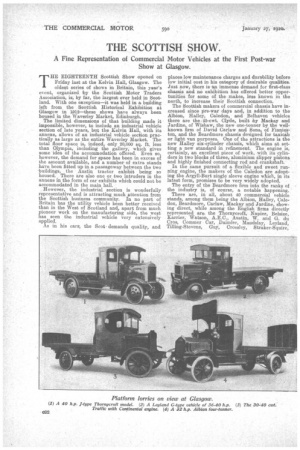THE SCOTTISH SHOW.
Page 14

Page 15

If you've noticed an error in this article please click here to report it so we can fix it.
A Fine Representation of Commercial Motor Vehicles at the First Post-war Show at Glasgow.
THE EIGHTEENTH Scottish Show opened on Friday last at the Kelvin Hall, Glasgow. The oldest series of shows in Britain, this year's event, organized by the Scottish Motor Traders Association, is, by far, the largest ever held in Scotland. With one exception—it was held in a building left from the Scottish Historical Exhibition at Glasgow in 1912—these shows have always been housed in the Waverley Market, Edinburgh. The limited dimensions of that building made it impossible, however, to include an industrial vehicle section of late years, but the Kelvin Hall, with its annexe, allows of an industrial vehicle seclion practically as large as the entire Waverley Market. The total floor space is, indeed, only 20,000 sq. ft. less than Olympia, including the gallery, which gives some idea of the accommodation offered. Even so, however, the demand for space has been in excess of the amount available, and a number of extra stands have been fitted up in a passageway between the two -buildings, the Austin tractor exhibit being so housed. There are also one or two intruders in the
i annexe n the form of car exhibits which could not be accommodated in the main hall.
However,. the industrial section is wonderfully representative and is attracting much attention from the Scottish business community. In no part of Britain has the utility vehicle been better received than in the West of Scotland and, apart from much pioneer work on the manufacturing side, the west has seen the industrial vehicle very extensively applied.
As in his cam the Scot • demands quality, and places low maintenance charges and durability before low initial cost in his category of desirable qualities. Just now, there is an immense demand for first-class chassis and no exhibition has offered better opportunities for some of the makes, less known in the north, to increase their Scottish eonnection. The Scottish makers of commercial chassis have increased since pre-war days and, in addition to the Albion, Halley, Caledon, and Belhaven vehicles there are the -25-cwt. Clyde, built by Mackay and Jardine, of Wishaw, the new one-tonner by the wellknown firm of David Carlaw and Sons, of Einnieston, and the Beardmore chassis designed for taxicab or light van purposes. One of the attractions is the new Halley six-cylinder chassis, which aims at setting a new standard in refinement. The engine is, certainly, an excellent piece of work, with its cylinders in two blocks of three, aluminium slipper pistons and highly finished connecting rod and crankshaft. In the same pursuit of a flexible and sweet running engine, the makers of the Caledon are adopting the Argyll-Burt single sleeve engine which, in its latest form, promises to be very widely adopted.
The entry of the Beardmore firm into the ranks of the industry is, of course, a notable happening. There are, in all, about 40 commercial vehicle stands, among them being the Albion, Halley, Caledon, Beardmore, Carlaw, Mackay and Jardine, showing direct, while among the English firms directly represented are the Thornycroft, Napier, Belsize, Karrier, Watson, A.E.C., Austin, W. and G. du C Gros, Commer ar, Daimler, Maudslay, Leyland, Tilling-Stevens, Guy, Crossley, Straker-Squire,
Laere, Dennis, AlIdays, and Vulcan. Altogether, over 50 different makes of British, French, American and Italian industrial vehicles are on view, so that the Show is thoroughly representative.
Agricultural tractors are few, but the Austin and Fiat examples are to be seen, whilst mention of the Northfield concern calls to mind the fact that they are showing their new 30-cwt. chassis. The Shaw remains open until Saturday next and, from a " gate " point of view, promises to be a great success. The stands are larger than at Olympia and the passageways are of ample width, so that a large attendance does not entail discomfort The main building is well ventilated and heated, but, unfor tunately, the ventilation of the annexe is more effec. tive than the heating. We believe the next step is to throw both buildings into one, which will give a floor space of no less than
200,000 ft. Even that, however, is a temporary measure, as the Corporation of Glasgow intend one day to utilize the whole of the 5,1,acres on which these buildings are situated for a permanent exhibition building, worthy of the great industries.of the West of Scotland. With such present and prospective facilities, it would appear very doubtful if the Scottish Show will ever be held again outside Glasgow, if only in view of the number of exhibitors crowded out in case of a change of venue.


































